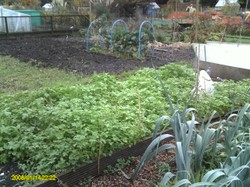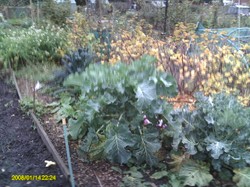One of the greatest developments in horticulture and agriculture was the realization that crops need to be rotated for the maximisation of production and the minimisation of disease. This understanding was at the heart of Britain's agricultural revolution in the eighteenth century, which prepared the ground for the industrial revolution to really take off, as it enabled food to be produced for the growing urban working class. Originally the British model used a fourfold rotation, but rotations have now become more sophisticated and complex.

Rotating your crops
by frankbeswick
Crop rotation has for many years been an important part of gardening practice.
The need for rotation
Lessons from Ireland
The greatest agricultural disaster to hit the British Isles was the potato famine. Note that I do not call it the Irish potato famine, as it hit elsewhere than Ireland, but Ireland was the place that suffered the most. We say that the cause was Phytopthera infestans, a horrid fungal disease, and this can strike anywhere, but what made it worse was that in Ireland the people were too desperate to rotate crops properly. The Irish were being made to grow the crops that were needed to pay rent and stay alive. Their corn went to pay rent, and they needed potatoes to sell to the mass English market. Thus they were forced to grow crops on the same land every year without rotation, and the potato variety that they grew was the lumper, which is seriously prone to blight. A double whammy!
The problem is this. During any season soil will pick up some plant diseases. So when my potato bed picked up some blight two years ago [the first time that it has happened] I decided that after that I would grow leeks on it the next year. then it will be two or three years at least before I grow potatoes in that bed. Thus the fungus will die of starvation, as it has no host to infect. But the Irish could not do this, as they were forced to grow every year on soil where diseases were becoming well established. Eventually there came a year when weather conditions were right for blight. Disaster! I do not need to speak of the horrors that ensued, especially to those of you whose ancestors were driven from Ireland at that time.
Not only does rotation prevent soil diseases accumulating, but it also balances the nutrient content of the soil. Individual vegetables take a specific cocktail of nutrients from the soil, and if you grow the same ones yearly you note that the specific nutrients diminish. Cotton is infamous for demanding overmuch from soil, which is why the sharecroppers of the American dustbowl, who were forced to grow cotton every year on the same land, soon became impoverished, as yields diminished [See Steinbeck's The Grapes of Wrath.]Of course nutrients can be replaced by fertiliser, but this has its problems as well, and does not replace humus as manure and compost does.
Gardening
 | Crop Rotation on Organic Farms Crop Rotation on Organic Farms: A Planning Manual provides an in-depth review of the applications of crop rotation-including improving soil quality and health, and managing pest... |
Rotation plans
The traditional British rotation was four-fold in vegetable fields. The farm was divided into fields. When one was doing potatoes, another was for beans and peas. Another was for brassicas, and the final one for roots, such as onions and leeks. This proved a simple rotation, but it became more sophisticated with time, as other plant families were brought in and space was made in the plan for cereals. For gardeners a complex rotation is very necessary, as vegetable gardens grow a wide range of plant families. Furthermore there has to be room for including winter crops in the planning. The basic principle, though, is that members of one vegetable family are succeeded by members of another, so if you are planting winter crops to succeed summer ones, make sure that you plant a family in the bed previously occupied by another family.
Some soils may exclude certain families, as may some latitudes. Where I am I can grow sweet corn, but not very well. So I have to choose my corn varieties carefully for colder latitudes and a damper climate. On my ground carrots for some reason do not do well, so I have had to grow them successfully in raised beds on imported compost.
Plant families:
Please note, some families have had their names changed over time.
Solanaceae: Potatoes, tomatoes, aubergines: Need lots of manure, and potatoes like some lime.
Legumes: Peas and beans: Are known for adding nitrogen to the soil, so many growers like to grow tham on ground where next year salad crops will be.
Alliaceae: [sometimes known as Liliaceae] Onions and leeks
Brassicaceae [sometmes known as Cruciferae] Cabbage, cauliflower. turnips etc. Need a pH of about 7. so add some lime to the soil before planting
Chenopodiceae: Beetroot etc
Cucurbitaceae: Cucumbers, marrows
Umbelliferaceae: Carrots, parsnips
Asteraceae: Lettuce and some others
Graminaceae: Sweet corn.Cereal crops tend to be in the maize family with sweet corn.
Fresca: strawberries. Fresca is a single genus rather than a whole family.
Herbs have their own rotation. There are five herb families, but three are mentioned above. These are Brassiceae [e.g. horse radish] , Umbelliferaceae [e.g parsley] and Alliaceae [e.g. chives] But we also have the Labiatae, the mint family. Those of you who dwell in very warm climates can add Zingiberaceae, the ginger family. There is no point in my trying to grow this family, as it needs climatic conditions far warmer than we find in the United Kingdom.
Apparently Umbellifers can be grown for two years in succession on the same ground, but I do not do this. Furthermore, the same applies to beans, which can grow well in the same ground for a while. But I take no risks with rotation.
Gardening clothes
 | Tierra Garden GGM0744 Garden Girl Pants, 44-Inch, Country Stripe Garden Girl clothing is a Scandinavian-designed line that has recently been introduced in the U.S. Besides being fashionable and fun, the full length pants are extremely durable... |
 | Sloggers 442DB01 Women's Wide Brim Braided Sun Hat with Wind Lanyard - Dark Brown - Rated UPF 50... Sloggers - Women's Wide Brim Braided Sun Hat with Wind Lanyard - Dark Brown - Rated UPF 50+ Maximum Sun Protection |
Alternatives
Not everyone uses rotation as strictly as organic gardeners do. Permaculturalists are committed to mixed planting in which all plants are intermingled. The advantage of this is that it imitates the way in which plants grow in the wild. Another advantage is that it prevents diseases building up and spreading through one bed. The disadvantage is that this technique is in human energy and planning terms quite demanding and takes much management.
There is also companion planting, in which plants are grown together if they get on with each other. A classic example is carrots, that grow happily with marigolds, whose scent deters carrot root fly. A major form of companion planting is the Native American technique of the three sisters bed. In this pumpkins, corn and beans are grown together, as these three make maximum effective use of the ground. The corn provides support for the beans, which occupy the higher zone, whereas the pumpkins, or other cucurbits such as squash, cover the ground and prevent weeds spreading.
Cereal farmers often have a more limited range of crops than organic gardeners, which is because they are governed by market demand. Often this means growing crops on the same ground or rotating more quickly than a gardener would. Many get round this by adding fertiliser, compost and manure to the soil to replace lost nutrients, but they still cannot get round the tendency of plant diseases to accumulate. There is also the problem of pests building up in one area where a plant family has been grown for too long. GM crops desisgned for herbicides can overcome this problem for a while, but evolution overtakes the herbicides and the GM. We are now getting super weeds and super pests resistant to the poisons that killed their kin. Already in southern England The glasshouse white fly has become immune to insecticides which killed off many of their species in glasshouses, leaving only the naturally resistant to survive and breed.
Ultimately rotation is a useful and practical technique for growing crops that can be used by farmers and gardeners alike.
Herb kits
 | Assortment of 12 Culinary Herb Seeds - Grow Cooking Herbs- Parsley, Thyme, Cilantro, Basil, Dill,... Grow your own culinary herb garden. This seed collection is the perfect way to grow the most common herbs and spices used in cooking. Includes lots of high germination rate seed... |
You might also like
Growing in confined spacesAs the world urbanizes and land pressures grow, many people are turning to im...
As Winter ComesFor true allotment gardeners gardening does not cease in winter,
Forest GardeningThe quintessential English garden is based on a lawn, but this is not a natur...




 Pilgrimage. A review26 days ago
Pilgrimage. A review26 days ago
 Leo the Fourteenthon 05/09/2025
Leo the Fourteenthon 05/09/2025
 The Melsonby Hoardon 03/25/2025
The Melsonby Hoardon 03/25/2025




Comments
Landlords needed a profit from their estates and only the cereals could provide It. Furthermore the country is not great for wheat, the climate is not right, Ireland is a land great for cattle and horses.
Thank you!
You characterize landlords as employing Irish barley for their beer.
Might the landlord-brewed beer have been consumed by landlord family and friends or would such beer have been sold?
No, Ireland was very poor.
Thank you!
Your comment March 2, 2024, in answer to my previous, same-day question, categorizes Irish rent-paying in corn versus English rent-paying in cash.
Your comment three boxes down, in answer to my question four boxes down, considers Irish growers of not only corn but also "low quality" wheat and barley.
Yesterday your comment below, in answer to my previous question, describes their landlords as buying their barley and wheat for respective beer-brewing and "cheap" bread-making sales.
Did Irish-grown barley and wheat get designated as "low quality" from something about their growing or -- ;-{ -- for their purchasers to get lower prices?
Barley was sold for beer brewing, wheat for cheap bread.
Thank you!
Your comment below, in answer to my previous, same-day question, describes Irish crop-growers as "low quality wheat and barley" farmers.
What did their landlords do with "low quality" products?
Low quality wheat and barley. The recipients of the wheat were the landlords.
The first subheading, The need for rotation Lessons from Ireland, considers that "The Irish were being made to grow the crops that were needed to pay rent and stay alive. Their corn went to pay rent, and they needed potatoes to sell to the mass English market."
Who constituted the corn-for-rent recipients? Were they mercantile or rich or some other socioeconomic-niched people?
It was the norm for Ireland, but England used cash.
The first heading, The need for rotation, notes that the Irish grew corn to pay rent.
Was corn the only way of paying rent, and was that the norm throughout what now is the United Kingdom?